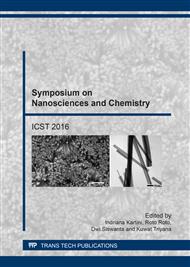p.142
p.149
p.154
p.160
p.166
p.173
p.182
p.190
p.197
Zeolite Loaded Alginate Membrane for CO2 and CH4 Separation
Abstract:
Natural zeolite-incorporated alginate membranes were subjected for the gas separation of CO2 and CH4. High concentration of CO2 as biogas product can decrease the combution heat. Therefore, the membrane permeability and selectivity of CO2 and CH4 were investigated. The zeolite-incorporated alginate membranes were prepared using solution technique. The effects of zeolite on the performance and the thickness of membranes for gas separation were analyzed. The membranes were characterized by Fourier Transform Infrared (FTIR), Scanning Electron Microscopy (SEM), Brunaur Emmet Teller (BET) and Barret Joyner Hallenda (BJH).The result of permeability and selectivity show that membrane can flow CO2 and resist CH4. CO2 permeability increased simultaneously with an increase of zeolite content in the polymer matrix. The thickness of membrane influenced the flux of CO2 gas. CO2 Permeability increased simultaneously with a decrease of membrane thickness. The membrane containing rasio of mass alginate:zeolite 10:2 and thickness of 0.1267 mm shows the best permeability. According BJH result, pore diameter of membrane is 3.64 Å, while kinetic diameter of CO2 is 3.30Å and kinetic diameter of CH4 is 3.80Å. This was explained performance of membrane was molecular sieving.
Info:
Periodical:
Pages:
166-172
Citation:
Online since:
July 2017
Authors:
Keywords:
Price:
Сopyright:
© 2017 Trans Tech Publications Ltd. All Rights Reserved
Share:
Citation:



